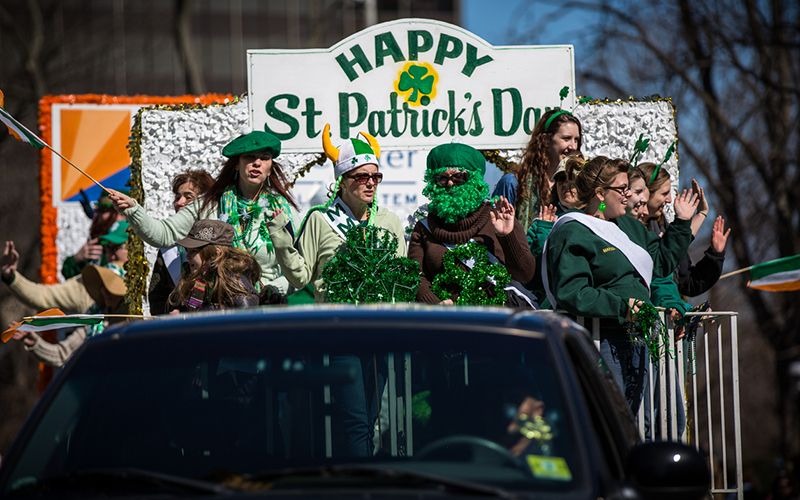No products in the cart.
Holiday
5 Facts About St. Patrick’s Day You Probably Didn’t Know
On March 17, the traditional death date of Saint Patrick (c. 385–c. 461), the most well-known patron saint of Ireland, is observed as St. Patrick’s Day, also known as the Feast of Saint Patrick. The introduction of Christianity to Ireland is attributed to Saint Patrick.
No 1. Saint. Patrick: Who Is He?
Saint Patrick’s Day, who was born in what is now modern-day Northern Ireland but lived during the fifth century, is widely recognized as Ireland’s patron saint and its national apostle. Although he was born in Roman Britain, he was kidnapped and sold into slavery in Ireland when he was 16 years old. Later, he was able to get away, but he eventually went back to Ireland, where he is credited with spreading Christianity to the locals there.
Patrick is thought to have passed away on March 17, 461; but, during the centuries that followed, the legends surrounding his life became more deeply ingrained in Irish culture: One of the most well-known traditions about St. Patrick is the one in which the saint is said to have explained the Holy Trinity (Father, Son, and Holy Spirit) using the three leaves of the indigenous Irish clover known as the shamrock.

No 2. What Year Was the First St. Patrick’s Day Celebrated?
According to Roman Catholic tradition, Irish people have been honoring Saint Patrick’s Day on March 17 since at least the ninth or tenth century. Instead of Ireland, the United States hosted the inaugural St. Patrick’s Day parade. According to historical records, a procession celebrating Saint Patrick’s Day was held on March 17, 1601, in the Spanish colony that is now St. Augustine, Florida. Ricardo Artur, an Irish vicar serving in the Spanish Colony, purportedly planned both the march and a St. Patrick’s Day event that happened a year earlier.
On March 17, 1772, a procession of homeless Irish soldiers serving in the English army marched through New York City in honor of Saint Patrick, the nation’s patron saint. The same incident occurred more than a century later. Following that, interest in the St. Patrick’s Day parades held in Boston, New York City, and other early American cities only increased.
No 3. Growth of St. Patrick’s Day Celebrations
A rise in Irish nationalism among immigrants to the United States over the following 35 years gave rise to groups calling itself “Irish Aid,” such the Friendly Sons of Saint Patrick and the Hibernian Society. Each organization’s annual parades would feature significant drum and bagpipe bands. The Scottish and British armed forces saw a rise in popularity for the bagpipes.
A number of New York Irish Aid organizations decided to unite their several St. Patrick’s Day parades to form a one official procession for the city of New York in the year 1848. This march attracts over 150,000 participants each year, making it the biggest and oldest civilian procession in the US as well as the oldest in the entire globe.
Each year, more to three million spectators line the 1.5-mile parade route to see the spectacle, which lasts for more than five hours. In addition to Savannah, Boston, Chicago, and Philadelphia also celebrate the holiday with parades. Each of these marches attracts between 10,000 and 20,000 spectators. The New York Municipal parade was one of the first big municipal events to be postponed in the year 2020 as a direct result of the COVID-19 epidemic. It was also postponed the following year, in 2021. The parade made a comeback in 2022 in New York City and other US cities.
No 4. History of Irish Americans
The bulk of Irish immigrants to the United States until the middle of the 19th century belonged to the Protestant middle class. In an effort to escape starvation after the Great Potato Famine hit Ireland in 1845, over a million poor and illiterate Irish Catholics started moving to America right once.
Since the majority of Americans practiced the Protestant religion and detested the immigrants’ strange religious beliefs and languages, immigrants in the United States had a tough time finding work of any type. Newspaper cartoons depicted Irish Americans as inebriated, irate monkeys when they celebrated St. Patrick’s Day in the nation’s cities by taking to the streets to honor their heritage.
Nonetheless, the Irish Americans realized pretty quickly that their sizable and continually growing population provided them political influence that they had not yet completely tapped into. They started to band together, and their voting bloc—the “green machine”—became a crucial swing vote for political candidates. All of a sudden, a wide range of political candidates felt compelled to participate in the annual St. Patrick’s Day parades, which had previously only served as a potent symbol for Irish Americans.
When President Harry S. Truman attended the St. Patrick’s Day parade in New York City in 1948, it was a magnificent occasion for the many Irish Americans whose forefathers had to battle stereotypes and racial prejudice to gain recognition in the New World. The occasion took place on March 17.
No 5. Various regions of the world celebrate St. Patrick’s Day with various festivals.
Today, especially in the United States, Canada, and Australia, people of many different races and cultural backgrounds come together to celebrate Saint Patrick’s Day. Even in nations that are quite removed from Ireland, such Japan, Singapore, and Russia, St. Patrick’s Day is observed. Although the biggest shows are hosted in North America, the occasion is celebrated elsewhere. Three foods are frequently cooked for Saint Patrick’s Day: Irish soda bread, corned beef and cabbage, and champ. Many people in the US wear green on Saint. Patrick’s Day to show their support for the Irish way of life.
In the past, Saint Patrick’s Day in contemporary Ireland was commemorated as a religious festival. As a matter of fact, up until the 1970s, Irish regulations mandated that bars close on March 17th. But starting in 1995, the Irish government began a widespread marketing initiative with the aim of leveraging St. Patrick’s Day enthusiasm to boost tourism and promote Ireland and Irish culture to the rest of the world. This campaign has not yet ended.
Conclusion
The Leprechaun is a figure that is frequently associated with the Irish holiday. These legendary figures were given the name “lobaircin” in Irish mythology, which means literally “small-bodied person.” Leprechauns are thought to have originated from the Celtic concept of fairies, which are characterized as being like small people with magical powers that can be used for good or evil. Leprechauns were irritable beings who were tasked with fixing their fellow fairies’ shoes, according to traditional Celtic folklore.
Leprechauns, albeit only minor figures in Celtic mythology, were renowned for their cunning, which they frequently used to protect the legendary treasures they guarded. Leprechauns have their own holiday on May 13 and are also celebrated on St. Patrick’s Day, when many people dress up as the inventive fairy.
Besides, don’t forget to check out our website Corkyshirt for more about gifts for St Patrick’s Day!
St Patricks Everybody In The Pub Getting Tipsy Sweatshirt
An Ideal shirt as a gift for St Patrick’s Day
BUY NOW


